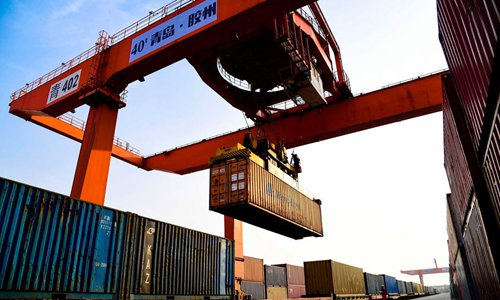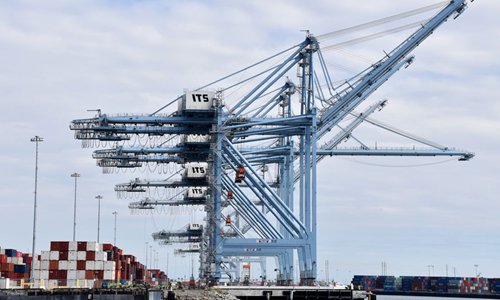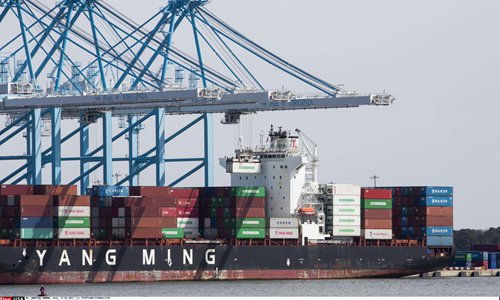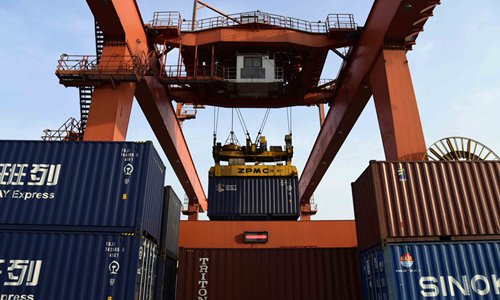HOME >> BUSINESS
Tariff hike on Chinese cranes to cost US ports extra multi-million dollars
Source:Xinhua Published: 2019/6/28 20:43:29

A gantry crane loads cargo onto a freight train bound for Central Asia at the Jiaozhou Bay International Logistics Harbor in Qingdao, east China's Shandong Province, May 7, 2018. (Xinhua/Guo Xulei)
US port officials are "disappointed" that gantry cranes came back on Washington's proposed tariff list after getting an exemption only a few months earlier, said Kurt Nagle, president and CEO of the American Association of Port Authorities.
These cranes generally cost "anywhere from 10 million to 14 million" US dollars per crane, and a 25 percent tariff hike would be "very significant" to US ports, many of which are currently purchasing new cranes to serve larger vessels with increasing volumes, Nagle told Xinhua recently.
Ship-to-shore gantry cranes, which move containers on and off the vessels, are the "largest and most expensive," Nagle said, noting that the "vast majority" of those cranes are manufactured in China.

Photo taken on Feb. 27, 2019 shows a view at the Port of Long Beach, Los Angeles County, the United States. (Xinhua/Li Ying)
Nagle, along with officials from Port of Virginia, Port of New Orleans, and Port Everglades, is among those who testified at the seven-day hearings held by the US Trade Representative's Office over the proposed tariff hikes on 300 billion US dollars' worth of Chinese products, which concluded Tuesday.
The tariffs on ship-to-shore cranes and other port equipment "would increase the cost of infrastructure investment and also potentially impact other needed infrastructure investment around the ports," said Nagle, whose association represents more than 130 public port authorities in the United States, Canada, the Caribbean and Latin America.
"So what happens to us is that's 10.3 million dollars less that's available to spend on another project, which equals jobs," said Glenn Wiltshire, acting chief executive and port director of Port Everglades, located in the southeastern US state of Florida.
Port Everglades ordered three low-profile gantry cranes, 13.8 million dollars per crane, from Shanghai Zhenhua Heavy Industries Co., Ltd. (ZPMC), currently the "only company in the world" that manufactures such cranes used in ports near airports, Wiltshire said.
The three cranes, scheduled for delivery in March 2020, will allow port container terminal operators to transfer containers from larger ships and boost container handling efficiency, he said, adding that the port is likely to order three more cranes from ZPMC in the next five years.
"Unlike the consumer market, we don't have the ability to take that additional cost and pass it on directly to our port users. We have long-term contracts with our container terminal operators," Wiltshire said. "You have to factor out and recover the capital investment cost over time."
If the tariff proposal is implemented, he said, "the resulting budget increase will require the reallocation of funds from other critical infrastructure projects," such as adding additional berths to handle more ships, and deepening and widening projects to dredge its channels.

The container ship Yang Ming is loaded at the Port of Virginia in Norfolk, Virginia on March 20, 2013. (Photo by Kristoffer Tripplaar/ Sipa USA)
This will directly affect US workers who would otherwise be employed on those projects and hamper Port Everglades investments in an expansion project necessary to serve exiting customers and keep the port globally competitive, Wiltshire said.
America's Heartland could also be hit, as many containers are bound to or from Ohio, Kentucky, Illinois and other central states, said John Reinhart, CEO and executive director of the Virginia Port Authority.
In his testimony last week, Reinhart said Port of Virginia has the largest percentage of rail containers for any port on the East Coast, helping create jobs in America's Heartland.
"The cost of imposing tariffs on gantry cranes poses a significant risk to continued economic growth for the communities of Virginia and beyond as well as the national economy by threatening a major East Coast port project," Reinhart said, who just ordered two ship-to-shore cranes from the Shanghai company in May.
With the sixth largest containerized cargo complex in the United States, the Port of Virginia has been investing significantly in terminal expansion, dredging and infrastructure spending, aiming to expand overall container capacity by 40 percent in its two primary container terminals in the near future.

A gantry crane loads cargo onto a freight train bound for Central Asia at the Jiaozhou Bay International Logistics Harbour in Qingdao, east China's Shandong Province, May 7, 2018. (Xinhua/Guo Xulei)
"There are no viable alternatives to source these cranes," Reinhart said at the hearing. "There are no US manufactures for these ship-to-shore gantry cranes, and there have not been any US manufactures for more than three decades."
The only two other companies that responded to the port's bidding announcement are from Europe, one with no experience in making such large cranes, and the other making its cranes in China, which has a well-established infrastructure in this area, he said.
Looking ahead, Wiltshire said US port officials have to be optimistic about persuading the administration to remove gantry cranes from the proposed tariff list once again, but will also be prepared for the worst. "I hope we don't have to go there," he said.
Nagle, meanwhile, said it is very important that Washington continues to negotiate with Beijing. "Hopefully these tariffs that are temporary in nature are able to be eliminated so that there is more stability and certainty in the trade environment on both the US and China exports and imports."
RELATED ARTICLES:
Posted in: ECONOMY